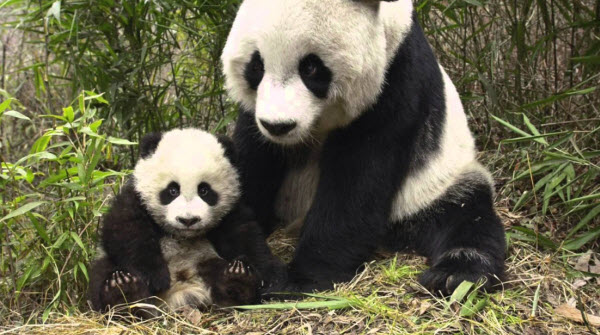The giant panda is a beloved animal, recognized for its round body and distinctive black-and-white fur. Regarded as a national treasure in its native China, it is legally protected in its bamboo forest habitats. The giant panda has long been revered in Chinese culture and is featured in artworks dating back thousands of years. Its charm has also captivated people worldwide, leading China to use pandas as diplomatic gifts to strengthen international relations. A notable example of this was in the 1970s when pandas were sent to U.S. zoos as part of the first cultural exchange between China and the West, known as “panda diplomacy.” Efforts to protect pandas from extinction have been significant, and recent reports indicate that their numbers in the wild are increasing. Consequently, the International Union for Conservation of Nature has reclassified them from “endangered” to “vulnerable.”
While the exact reason for the giant panda’s coloration remains uncertain, one theory suggests that its contrasting black and white fur evolved to help pandas stand out in the forest, making it easier for them to find each other for mating. Another theory posits that the colors provide camouflage among bamboo or in the forest canopy, making it difficult to spot young pandas. Each panda has slightly different markings, and in rare cases, a mix of brown and white fur can occur. Scientists have debated whether the giant panda is a type of bear, raccoon, or a unique combination of the two. Genetic studies have confirmed its close relation to other bears, particularly in terms of walking, climbing, skull features, social structure, and reproductive biology. Understanding these aspects is crucial for helping pandas reproduce and survive.
The giant panda is among the most vocal of bears. Its most distinctive sound is a “bleat,” similar to the bleat of lambs or kids. Other sounds include growls and barks, used for communication alongside other methods. Both male and female giant pandas have a gland that secretes a waxy scent from beneath their short tails, which they mark on trees, rocks, bamboo, and shrubs. This strong scent can be detected by human noses from up to 0.3 meters away. The scent serves as a social billboard, indicating the presence of other pandas in the area. It also helps pandas determine the sex, age, reproductive status, and social condition of others, as well as the age of the scent marks. Male pandas often practice standing on their hind legs to leave scent marks higher up on trees.
Giant pandas inhabit the mountainous regions of southwestern China, in moist coniferous forests at elevations between 1,200 and 3,500 meters. These areas provide the bamboo and water they need, as well as old, hollow tree trunks that can serve as suitable dens. Their home range typically spans 8 to 18 square kilometers, though in areas with scarce food, it can be larger, and males have a broader range than females. Like other bears, pandas spend most of their day sleeping and eating. Bamboo is their primary food source, and they spend at least 12 hours a day consuming it. Due to bamboo’s low nutritional value, pandas eat large quantities daily, using their five fingers and a specialized bone called the “false thumb” to grasp and manipulate it, similar to how humans use their thumbs.

Giant pandas use their teeth to peel the tough outer layers of bamboo stems to access the softer inner tissues. Powerful jaw and cheek muscles help them crush and chew the thick stems with their flat back teeth. They also eat bamboo leaves, stripping them from the stems. In the wild, pandas may consume grasses, fruits, insects, rodents, and carrion, essentially anything edible they encounter. In zoos, their diet includes bamboo, carrots, sweet potatoes, apples, and a special biscuit made from grains, packed with necessary vitamins and minerals.
Giant pandas are solitary by nature, valuing their personal space due to their need for substantial amounts of bamboo each day. When two pandas meet, they may engage in fierce fights, often biting each other, and usually coexist only under exceptional circumstances, such as mothers with cubs or during the very brief mating season. Female pandas signal their readiness to mate through distinctive scents, which males detect and use to stay close and monitor the female until she is ready to mate. This timing is crucial, as females are only receptive for two to three days. Once the female is no longer receptive, the male moves on to find another willing mate. Pandas have a slow reproduction rate, with females typically breeding once every two to three years. In their natural habitat, a female may give birth only about five times in her lifetime.

At birth, panda cubs are about the size of a stick of butter, hairless, and helpless. The mother provides extensive care, holding her cub close to her chest. For the first few days after birth, she does not leave the den even to eat or drink. Cubs open their eyes 50 to 60 days after birth and start crawling at 10 weeks old. They begin to play with their mother around 21 weeks and start trying bamboo at 7 to 9 months, continuing to nurse until about 18 months. At this point, the mother will wean the cubs to prepare for the next pregnancy. Once the cubs weigh around 50 kilograms and are about 2.5 years old, they are generally safe from predators. Young pandas are vulnerable to predators like tigers and leopards due to their relatively slow movement on the ground, so they climb high in trees for safety until their mothers return.
Today, giant pandas face significant challenges. As of 2016, over 1,800 pandas lived on Earth, and they were classified as “endangered” on the IUCN Red List. Thanks to extensive conservation efforts, their status was updated to “vulnerable.” However, many still face serious threats, including habitat destruction due to China’s expanding population and urbanization. Activities such as mining, logging, and land conversion for agriculture have halved the suitable habitat for pandas between 1974 and 1985, isolating them in small patches surrounded by human development. This habitat fragmentation makes it difficult for pandas to move safely between areas and exposes them to greater risks. Additionally, habitat destruction leaves cubs more susceptible to cold, disease, and predators.

Another major issue is the low reproductive rate of giant pandas. As mentioned, pandas prefer solitude for most of the year, resulting in a very short breeding season. When searching for a mate, a female may give birth to one or two cubs, but typically only one survives due to maternal neglect of the other. To address this, wildlife care specialists in panda facilities in China often care for one cub while the mother tends to the other, swapping them every few days to ensure both receive adequate care and nutrition. Another challenge is the slow growth of bamboo, which requires pandas to move between areas to find enough food. Therefore, an ideal panda habitat should include various bamboo species. Furthermore, poaching poses a threat when traps set for other wildlife, such as musk deer, accidentally capture and kill pandas.
Conservation efforts for giant pandas began in China in 1957 and 1989. The Chinese Ministry of Forestry and the World Wildlife Fund developed a plan to protect pandas and their habitats, reduce human activities in their range, manage bamboo forests, and expand protected areas. In 1998, China’s natural forest conservation program provided protection to all remaining panda forests, covering 5.7 million acres, and established 65 reserves, some of which are completely off-limits to people, while others are designated for shared use, such as national forests.
Identification Card

- Class: Mammals
- Order: Carnivores
- Family: Ursidae
- Genus: Ailuropoda
- Lifespan: 14 to 20 years in the wild; up to 30 years in human care
- Gestation Period: Approximately 135 days; documented range in zoos from 100 to 180 days
- Birth Weight: 85 to 142 grams; typically one or two cubs
- Maturity: Females 4 to 5 years; males 6 to 7 years
- Length: About 1.5 meters
- Weight: Females 70 to 100 kg; males 86 to 125 kg
- Height: 70 to 80 cm at the shoulder
Quick Facts about Giant Pandas
- Giant pandas defecate frequently, up to 50 times a day. Biologists use panda droppings to locate them in the wild.
- They have unusually thick and heavy bones relative to their size, but are also very flexible, aiding in their acrobatic movements.
- Almost all pandas, including those born in zoos around the world, are originally from China.
- Like other bear species, giant pandas are curious and playful, especially as cubs. In zoos, they enjoy playing with ice piles and sawdust.
- Occasionally, a female panda may be pregnant with twins but only gives birth to one, as her body reabsorbs the other fetus.
- Scientists have identified 12 distinct vocalizations made by pandas.
